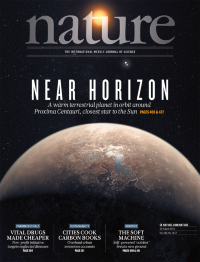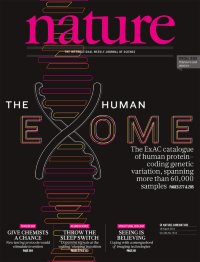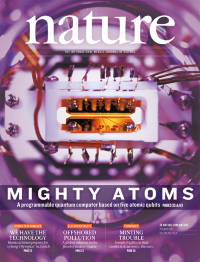Volume 536
-
No. 7617 25 August 2016
An artistic representation of Proxima Centauri and its planet Proxima b. An analysis of previously obtained observations and new Doppler data from instruments at the European Southern Observatory (ESO) reveals the presence of a small planet with a minimum mass of 1.3 Earth masses orbiting Proxima Centauri, the nearest star to the Sun. The planet, designated Proxima b, is in a close orbit with a period of approximately 11.2 days. Its equilibrium temperature is within the range where water could be liquid on its surface, although the current composition and existence of water on its surface are unknown because X-ray fluxes higher than those experienced by Earth might have produced a rather different atmosphere from our own over time. The discovery of a warm terrestrial planet orbiting a nearby star offers opportunities for further characterization including � as technologies evolve � by direct imaging and high-resolution spectroscopy. Cover art: ESO/M. Kornmesser
-
No. 7616 18 August 2016
As part of the Exome Aggregation Consortium (ExAC) project, Daniel MacArthur and colleagues report on the generation and analysis of high-quality exome sequencing data from 60,706 individuals of diverse ancestry. This provides the most comprehensive catalogue of human protein-coding genetic variation to date, yielding unprecedented resolution for the analysis of very rare variants across multiple human populations. The catalogue is freely accessible and provides a critical reference panel for the clinical interpretation of genetic variants and the discovery of disease-related genes. Cover: Kelly Krause/Nature
-
No. 7615 11 August 2016
Version 1.0 of the Human Connectome Projects multi-modal human cortical parcellation on a left hemisphere surface model. For more than a century, neuroscientists have sought to subdivide the human cerebral cortex into a patchwork of anatomically and functionally distinct areas. Until now such maps have relied largely on only a single property such as micro-architecture or functional imaging, have been based on a relatively small number of individuals, and have usually been blurry due to misalignment of brain areas from person to person. Matthew Glasser, David Van Essen and colleagues have tackled these deficiencies in a new more universal� map of the human cerebral cortex by integrating multi-modal imaging data obtained from 210 healthy subjects and validated on 210 other individuals. The authors propose a total of 180 areas per cerebral hemisphere (97 of them previously unknown) and apply a machine-learning classifier to automatically identify these areas in new subjects, even in individuals with atypical parcellations. This freely available resource will enhance the anatomical accuracy and interpretability of future structural and functional studies of the human brain in health and disease. Cover: Matthew F. Glasser & David C. Van Essen.
-
No. 7614 4 August 2016
A photograph of an ion trap, showing the four blades forming the electrodes of a radio-frequency Paul trap confining a linear chain of ions that can be optically addressed. The functional quantum computer is eagerly awaited in certain circles. For instance, for problems such as simulation of chemical reactions and factoring large numbers, a quantum computer would outperform any classical computer. Although algorithms have been run on small quantum computers, it has not so far been possible to design a programmable quantum computer that is easily reconfigurable and in which different algorithms can be compiled without changing the hardware. In this issue of Nature, Shantanu Debnath and colleagues demonstrate such a small programmable quantum computer, using five trapped atomic ions as qubits. The architecture could in principle be scaled up to a larger number of qubits. Cover: S. Debnath & E. Edwards, Joint Quantum Institute.




